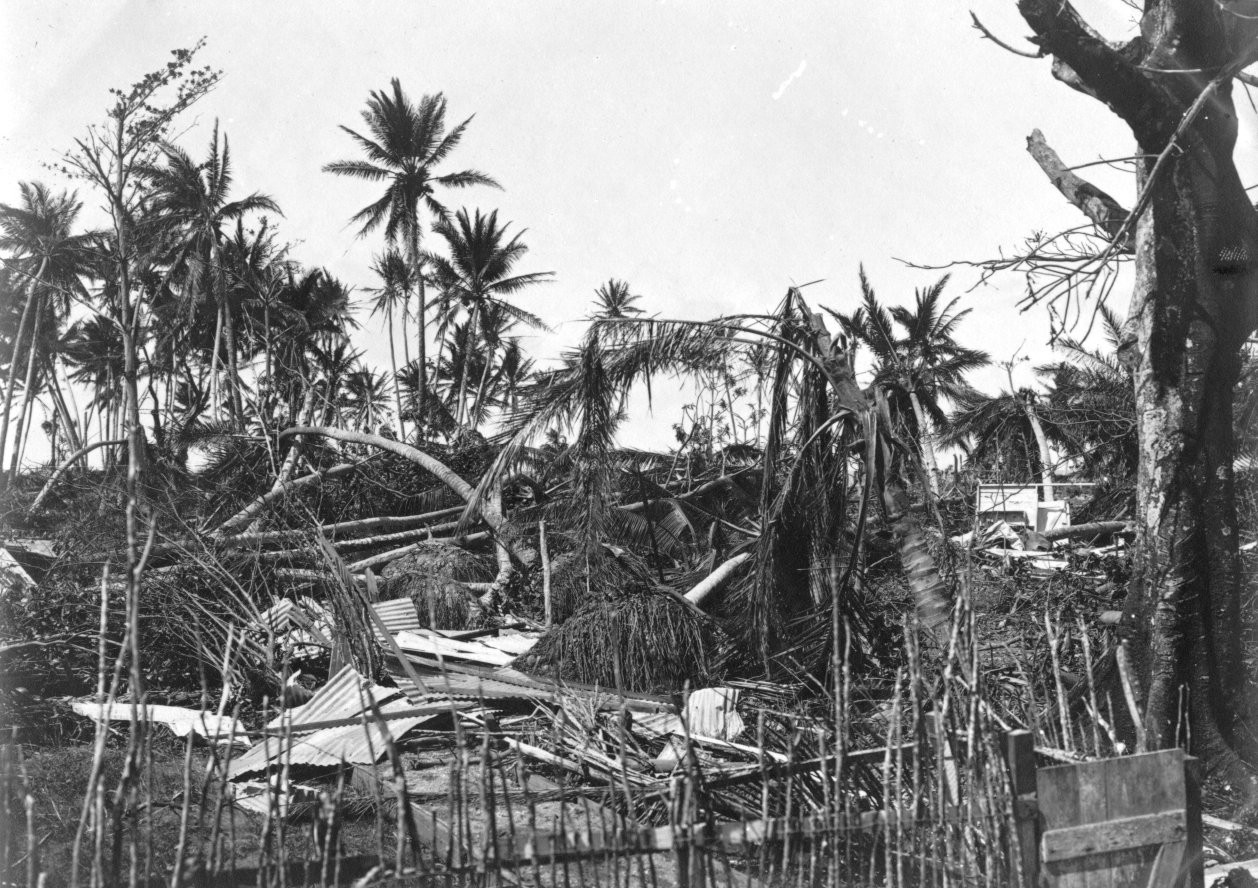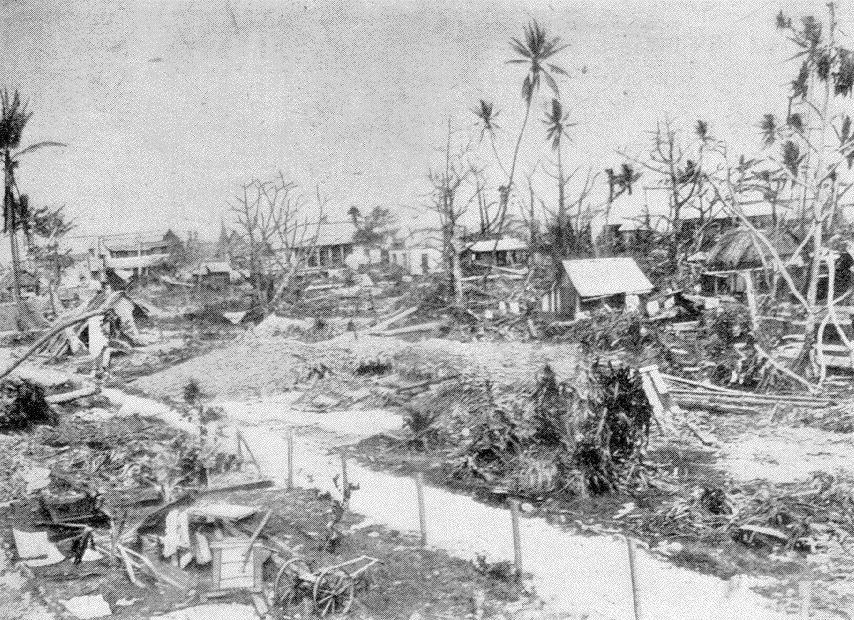`Typhoons do not occur on Jaluit'. Words to that effect were frequently uttered
by traders and skippers working for German firms in the Marshall Islands and
faithfully reported by travel writers and ethnographers. Indeed, in the short
time German and other traders had been working in the Marshalls, the effect of
typhoons had been comparatively small. Some events had occurred, but none
memorable enough.
All of this changed on June 30th, 1905. A typhoon struck the southern
Marshalls, devastating Mile, Nadikdik and Jaluit and severely affecting Arno
and Majuro. Over 227 Marshallese lost their lives on that day. In subsequent
months approximately another 90 people died of starvation as a result of
destroyed food stocks.
On Mile the wind set in with unusual strength at 8 am, coming from northeast.
At about the same time heavy seas began washing across the islets. At about 9am
three gigantic waves, one larger than the others, hit Mile Atoll, and washed
over the islands. The storm wave effect was compounded by a high tide.
According to eye-witnesses, the third and largest of the waves, was as high as
the tops of the coconut trees. Even if we take exaggeration into account and
allow for the crest of the waves to consist of wind-driven foam, a wave height
of some 16-24 feet can be estimated. Some eighty people died.

Devastation On Jaluit
Neighbouring Nadikdik Atoll was completely washed over, with several
inhabited islands completely eroded down to the bare reef platform. The
population of that atoll, comprising some sixty people, was completely
extinguished save for two boys who survived a 24-hour drift voyage clinging on
a breadfruit tree to the southern coast of Mile.
Majuro lost a land area of a total of 3 miles length, when the waves breached
the narrow strip of land on two locations on the southeastern coast, between
Rairok and Delap.
The northeastern islets of Jaluit, were most severely affected with the passing
over. Several were completely washed away and reduced to the underlying reef
platform. Over seventy people lost their lives. The casualty figures for
Jabwor, south of the eye, were comparatively light. One Marshallese had been
killed by a falling roof beam, and several people, among them one of the
Catholic brothers, had sustained broken limbs etc. caused by falling debris or
by being hit by rocks and other debris while being washed about by the cyclonic
surge.
When the typhoon passed over Jaluit a it was low tide and so the impact was
substantially less than on Mile or Nadikdik. Had the typhoon struck at high
tide, the number of casualties on Jabor would have been much higher. Despite
this, 78 people drowned on the northern islets of Jaluit when the eye passed
over.
Flooding occurred, also on Jaluit several ships sunk in the lagoon or were
driven onto reefs by waves and winds. The entire European settlement was
flattened bar one building: all expatriates and many Marshallese living on
Jabwor congregated in the ware house of the Jaluit Gesellschaft, then the
strongest building on the island.
Based on the damage shown in the available historic photographs, we can
reconstruct that Jabwor, at the less dangerous southern side of the eye would
have experienced sustained winds of 100-105 knots. The northern edge, however,
would have been exposed to 130-135 knot winds. To put this into a modern
context: this is approximately the same strength as hurricane Andrew which hit
Florida few years back.
The typhoon then moved westwards, with limited impact and only small scale
flooding on Namorik and Ujelang. Following a path not unlike that of `Paka',
the typhoon moved northwest and on 5 July 1905 where it struck the islands
Alamagan, Pagan and Anatahan in the Marianas devastating the copra plantation
there.

After Initial Clean-up
The lagoon of Mile and to a lesser extent that of Jaluit were reported to be
choc-a-bloc full of floating debris: trees, bushes, houses, broken canoes,
wooden utensils and corpses. The concentration of drift material in the waters
of the Marshalls during July and August 1905 was so high that it constituted a
serious shipping hazard, making the very limited relief operations not any
easier.
What is particularly unusual about this event is the lack of disaster relief
that occurred. While Germans are normally noted for their efficiency and
thoroughness, this was not the case in Jaluit.
The presence of the postal steamer `Germania' en route to HongKong meant
that news of the event could be carried swiftly to Yap, where Germany had a
telegraph station, and from there to Berlin as well as to the naval
headquarters of the German East Asia squadron in Jiazhou (Quingdao, China).
It also meant that any steps taken to mitigate the impact could be implemented
in the shortest time possible. The German administration, led by the old
Pacific hand `Landeshauptmann' Eugen Brandeis, as well as the commercial
interests swung into action. When the `Germania' left on 4 July 1905, the
administration had reached the following decisions:
a) to order timber from San Francisco to rebuild the houses;
b) to hire (temporarily) Chinese carpenters in HongKong; and
c) to order supplies etc., as building supplies were in very short supply.
When the steamer had left, the German administration seems to have gone into
some form of stupor. While the trading companies were intent on rebuilding
their stations as quickly as possible, the German administration did nothing.
As the typhoon had come from the east, one would expect that the administration
would take steps to ascertain whether the atolls of Mile and Arno/Majuro were
also affected by the typhoon. Two two-masted schooners had been driven ashore
in Jaluit, but could be refloated the following week. Thus shipping was
available--but no action was taken.
In late July the German naval vessel SMS `Seeadler' arrived, having come to
Micronesia to assist in mitigating the effects of an earlier typhoon in the
Eastern Carolines (On 19 & 20 April 1905 it had devastated Kosrae,
Pingelap, Pohnpei, Mokil and several other atolls). Even though Brandeis now
had warship at his disposal, which could be used to investigate other islands,
and even though by that time news of the devastation of the other atolls had
filtered back to Jaluit, he did--nothing.
On these atolls, especially Mile, most of the fruit trees were either damaged
or destroyed, leading to a glut of food in the first two weeks after the
typhoon and then to extreme food shortages. The starvation period would last
for six to nine months. Unless help would be provided, many deaths were
certain to occur. Fortunately, the traditional responses to typhoons were still
in the minds of people. A number of people moved from Mile to Arno, and the
people of Majuro provided food for Arno to reduce the impact of typhoon and
additional population.

Landeshauptmann Eugen Brandeis
Yet this was not enough. More than 70 people died on Mile of starvation.
Deaths which could have been avoided if Brandeis would have cared for the
people under his responsibility.
This government inertia continued even after early 1906 when Brandeis had gone
back to Germany, having finished his tour of duty. His Deputy, Ludwig Kaiser,
then in an acting role as district administrator, did nothing either. When the
Vice-Governor of German Micronesia, Dr. Victor Berg was to arrive on an
inspection visit on 26 May 1905, he found the German colony in confusion.
Unable to face up to the lack of action, Kaiser had killed himself the day
before.
Aghast by what he found, Berg, immediately swung into action. A man of a
different caliber, he immediately investigated Mile, Arno, and Majuro and
implemented the required food drops and organised increased evacuation of Mile
to Arno. Almost one year later disaster relief finally occurred.
We are left wondering why nothing had happened for so long. True, the German
administrators were not used to typhoons and no idea of their impact on the
people and islands of Micronesia. But this is no excuse for inaction.
Jaluit, the pearl of German Micronesia, had been turned to rubble overnight. It
is quite likely that the suddennes and extent of devastation overwhelmed the
German administration. But even this is no excuse for inaction, certainly not
for such a prolonged length of time.
One is left with the uneasy feeling that the administration at the time simply
did not care what happened to the people on the outer atolls. And we can be
grateful, that adminstrators such as Brandeis were the unfortunate exception,
rather than the norm
[Home Page]

Bibliographic citation for this document
Spennemann, Dirk H.R. (2000) Recalling the Typhoon of 30 June 1905 and its aftermath. Albury. URL: http:/marshall.csu.edu.au/Marshalls/html/climate/Typhoon1905.html

CONTACT:
Dirk H.R. Spennemann,
Institute of Land, Water and Society,
Charles Sturt University, P.O.Box 789,
Albury NSW 2640, Australia.
e-mail: dspennemann@csu.edu.au

(c) Dirk H.R. Spennemann 2000

